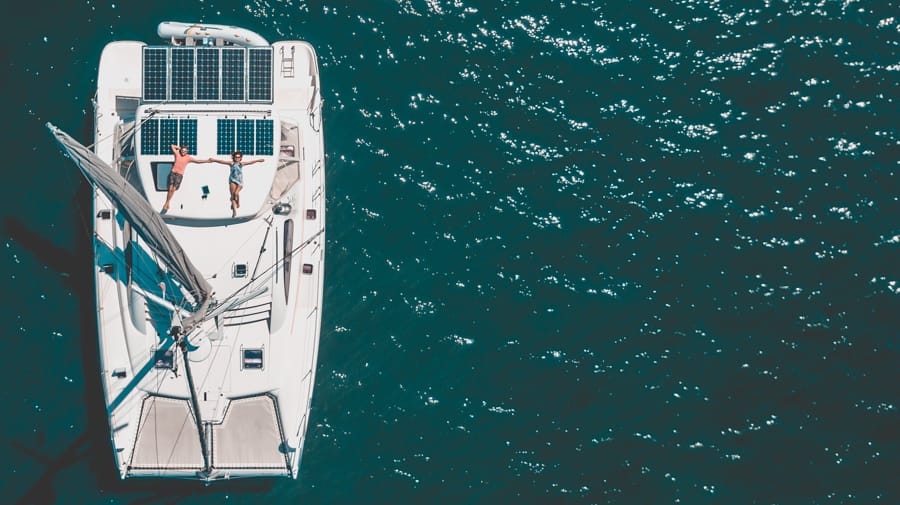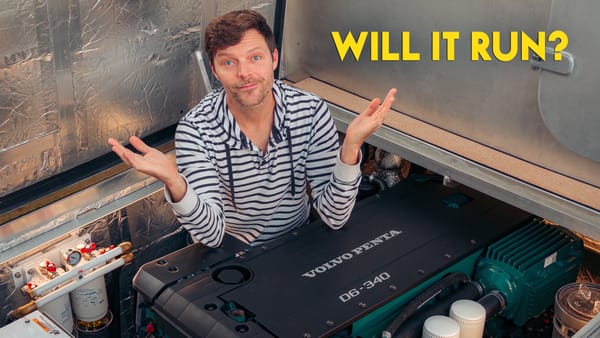Amped Up – How We Charge Our Boat Batteries

Living off the grid on a sailboat is all about managing resources. And so many of our resources need electricity (like our watermaker). We’ve talked about the importance of investing in good batteries and our choice of battery. Now, were sharing the different ways we charge our lithium batteries.
Our power needs are what plenty of sailors would call extreme. But, hey, to each their own. Living off the grid isn’t a competition of who has the least or the most. We all go about it a little different. That’s the beauty of the sailing lifestyle, its customizable. Our wants and needs are just that, ours. What works best for you might be way less or perhaps even more.
Our first experience with a traveling home was an old VW Vanagon. We loved our dusty, 80’s gold camper (even honeymooned in it) but the engine battery was our only source of power. It couldn’t handle much. Leave a cell phone plugged in overnight and we would need a jump by morning. But, roaming around the southern states in that VW is what sparked the idea of full time travel.

Fast forward eight years, a few roaming homes and multiple power set ups later, man have things changed. Now we have a sailboat that could power a small village. Ok, maybe not, but it is pretty amazing what we can do while floating in the middle of the ocean.
We’ve had a ton of trial and error with our electrical set ups. One BIG thing we’ve learned: options are good, especially when it comes to charging batteries.
Batteries are like the fuel tank in a car. We can only cruise around so long before the tank is empty. At some point, we need to fill it back up. Plus, batteries are the heart of our systems. The battery bank pumps life into all the other electrical bits of our sailboat.
We’re not experts by any stretch of the imagination, but we know what works for us. Perhaps seeing our set up, and each of our charging methods, will spark some ideas for you.
Whaddya think? What’s your favorite method of topping up your battery bank? Do you know of some super awesome, crazy efficient, power producing gadget? If so, don’t keep it to yourself, tell us about it in the comment box below!
We could go cross eyed analyzing different manufacturer specs and guessing how each device would perform in “real-world” use. It still blows me away that our 80a alternators would take so long to charge up our batteries…but that said, a lot of sailors rely solely on their engines for charging. It’s all relative to the battery bank and how much power you need. If you have a small sailboat with a 100ah battery you probably don’t need much. But, if you have a big boat and want to live like you’re on the grid, even when you’re not, you’ll need some beefy upgrades.
Overall, we’re smitten with what our system is capable of and how little we run our generator. It’s blows me away how long we could stay out to sea before needing to come to land. If we were willing to only eat beans, rice and fish…we might go a year before coming ashore (but let’s not test that theory). Here’s what we have aboard Curiosity.
The Gadgets and Gear
- 1200 Amp hours of lithium batteries – gonewiththewynns.com/product/lithium-batteries
- 2000 Watt Inverter – gonewiththewynns.com/product/2000-watt-inverter
- Amp Clamp – gonewiththewynns.com/product/amp-clamp
- Battery Monitor Kit – gonewiththewynns.com/product/battery-monitor
- Adapter Cables For Shore Power – gonewiththewynns.com/product/30-amp-to-50-amp-y-adapter
- Engines – Our catamaran has the factory upgraded Yanmar 39hp engines with the standard 80a alternator. We’d love to upgrade the alternators in the future. We couldn’t spring for it when we were in Florida and it wasn’t a service priority.
- Generator – Our sailboat came with a Northern Lights 6kw generator in the port lazarette. It’s relatively quiet, works well and is considered the industry standard for most cruisers. That said, it’s big, heavy and expensive! We’re looking into smaller, lighter and more efficient options for the future (but not until our current gene dies).
- 1400 Watts of solar
- 600 Watts of Flexible Solar – gonewiththewynns.com/product/flexible-solar-panels
- 800 Watts of Rigid Panels – gonewiththewynns.com/product/160-solar-panel
Solar Arch & Dinghy Davits – We get asked a lot about our solar arch and davit system. We decided on this set up because is solved a host of issues.
- The arch sets our panels up for maximum sun exposure and minimal shading from the lines, rigging and sails. Turns out this is far more important that we expected. See the full scoop here: gonewiththewynns.com/Sailboat-Solar-Series-Parallel-Shading
- The davit system from the factory suspended the dinghy to low and left it susceptible to damage from waves. Our new davit system not only holds our solar panels but it gets our dinghy up 5 feet higher which makes sailing in heavy seas much safer for us and the dinghy.
- By extending the panels out past the hard top, we have extra shade which helps extend the life of our dinghy and our skin.
The system was designed and custom built by Just Catamarans. Its made with heavy duty stainless steel to survive years of off-shore sailing. It was an expensive upgrade as the custom stainless work alone set us back $12K and a few weeks. It wasn’t an easy one to fork over the money, but it’s one we are happy we bit the bullet on. Plus, it’s an investment that adds to the overall value of the boat…or at least that’s what Kent told us to ease the pain.
Feeling Tipsy?
Thank you soooo very much for watching, reading and virtually hanging out with us! If you like what you see here and want to show some digital love, check out our Say Thanks page. There are lots of ways you can help us keep the videos flowing. Best part is, most won’t cost you a penny.
Cameras Used to Capture This Video
Full Review Of All Our Camera Gear: gonewiththewynns.com/camera-gear-review-2017
- Sony A7ii: com/product/sony-a7ii
- Rode Mic: https://bhpho.to/2hUNFA8
- Sony 24 – 70mm f4 lens: com/product/sony-24-70
Drone
- DJI Mavic Pro: http://amzn.to/2vUFXa6
- Drone Filters: http://bit.ly/sandmarc-mavic




